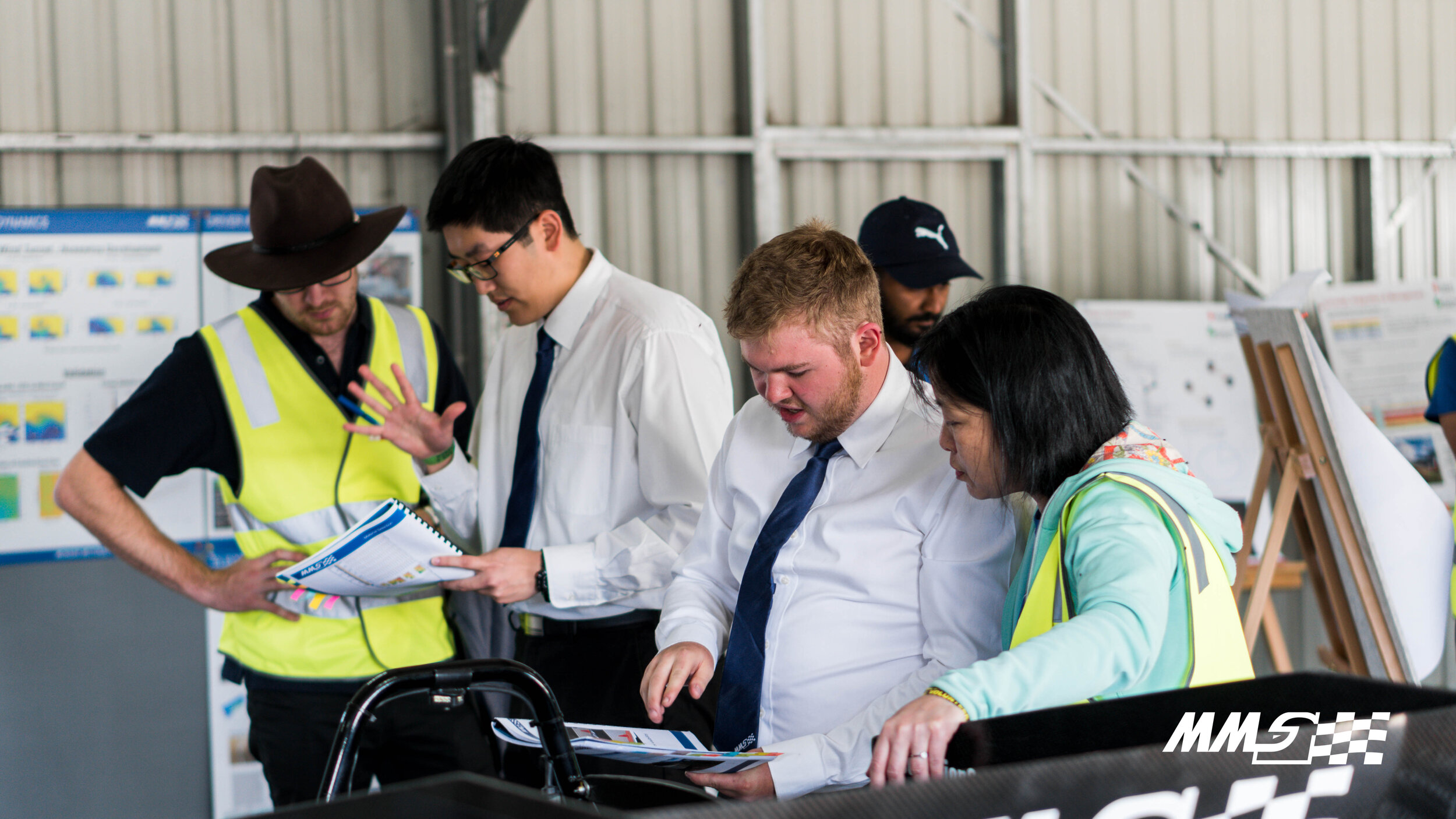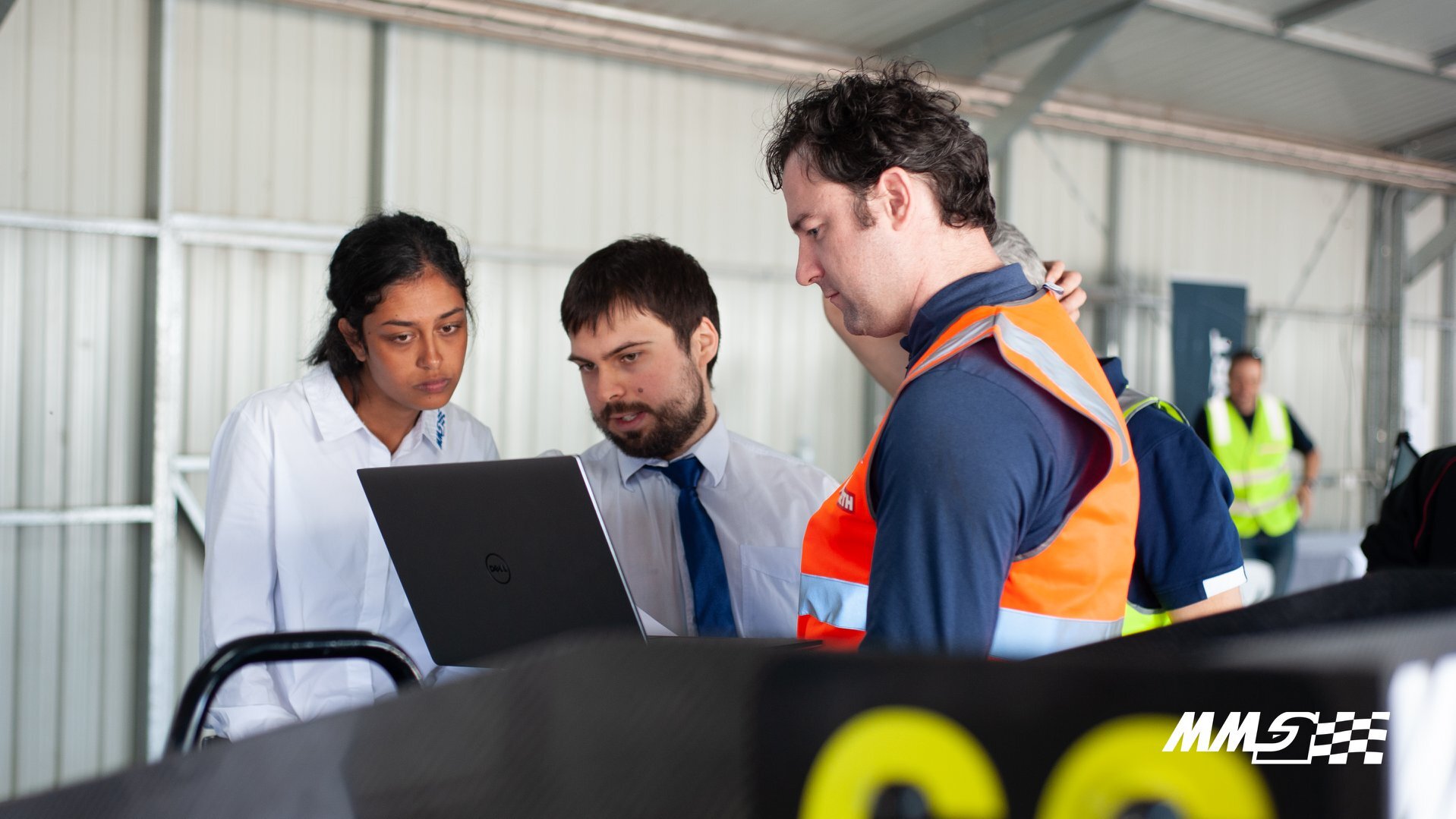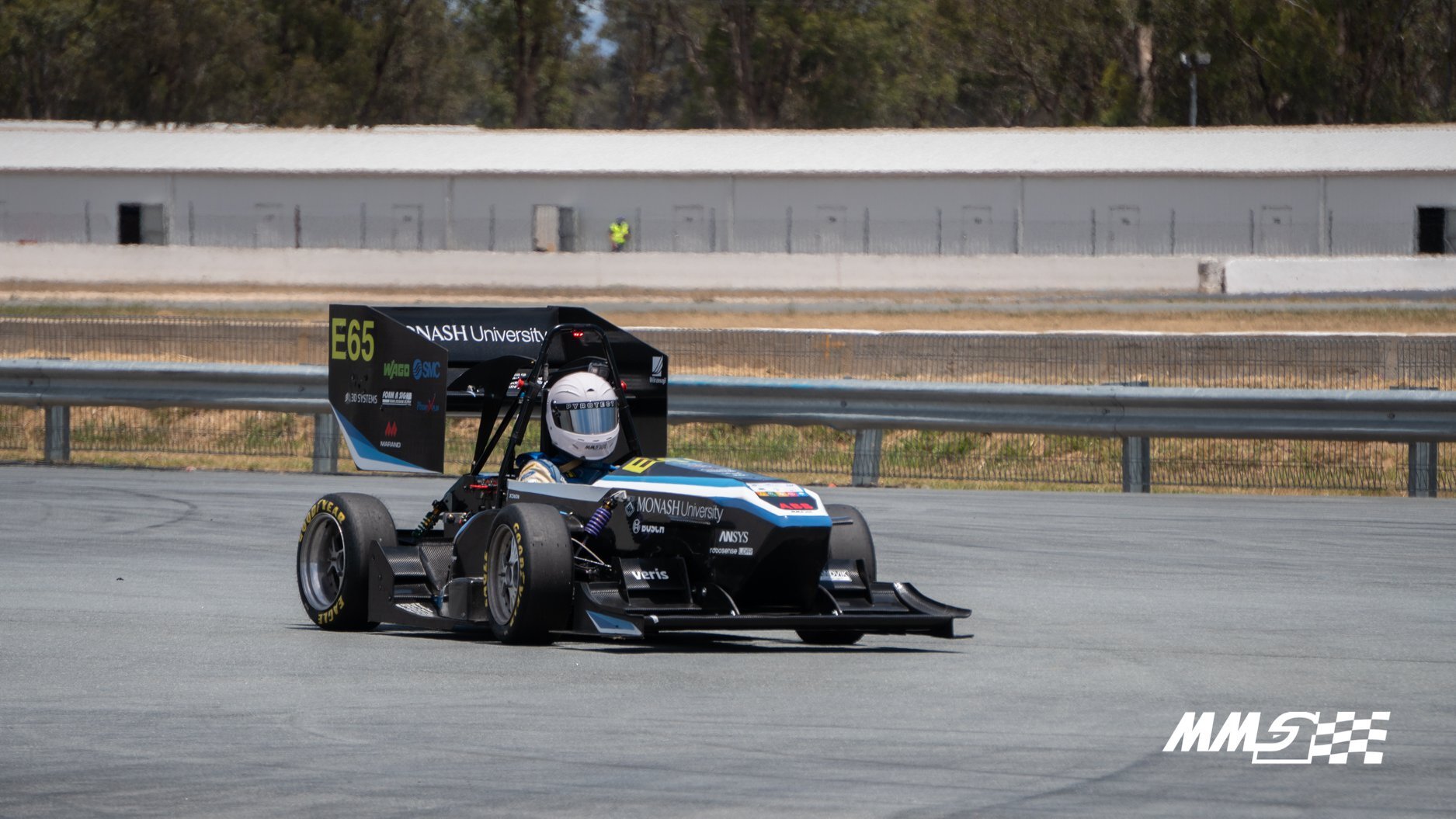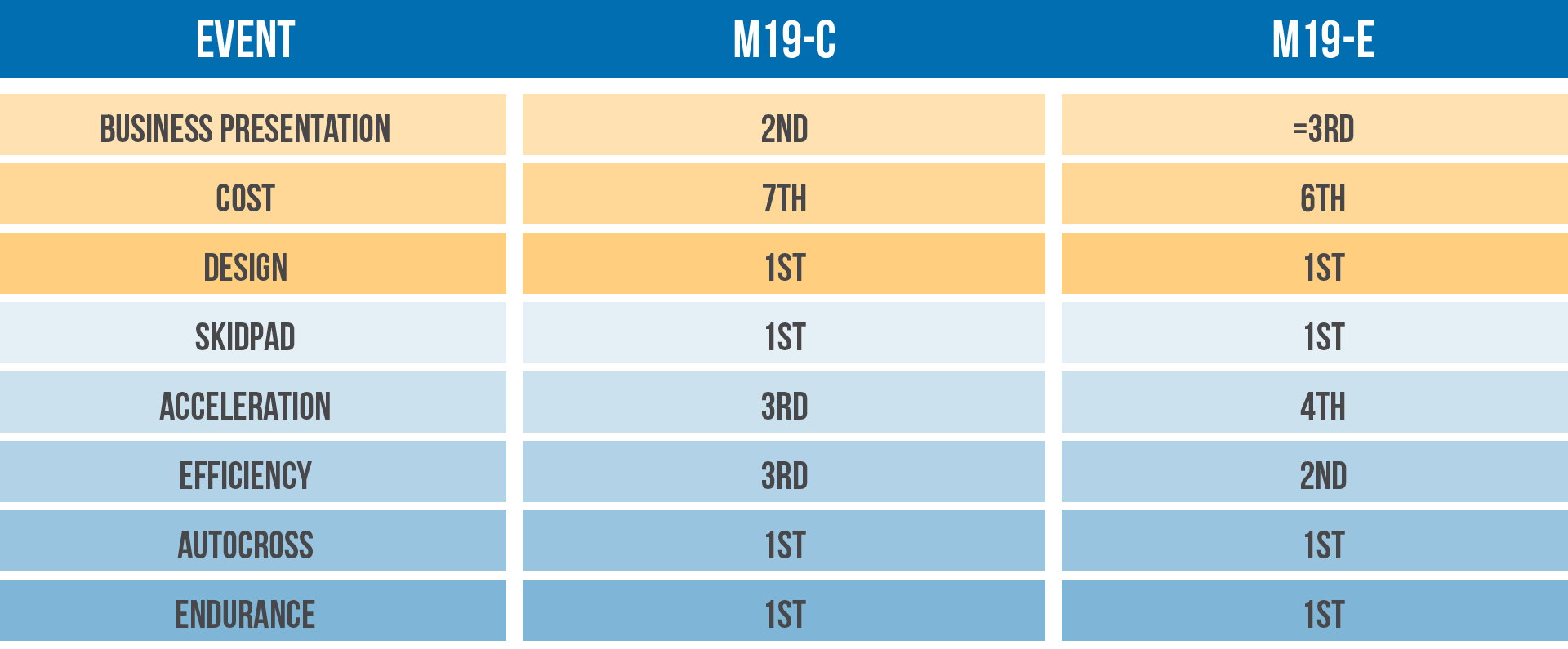FSAE Australasia 2019: One Team, Three Cars
With all the challenges that we’ve faced in 2020 so far, FSAE Australasia 2019 truly feels like a lifetime ago. Although we’re all doing our part to keep everyone safe by staying home, and while we continue to react and adapt to the changes at hand, our team feels that there is no better time than the present to reflect on our 2019 Formula SAE Australasia experience.
WEDNESDAY DECEMBER 4
While most of the team made our way up to Winton Motor Raceway with all the tools, food and camping equipment we would need for the weekend, a few team members stayed behind to oversee some final testing for M19-E.
As we arrived at the track, the campsite that we’d called home 12 months earlier greeted us once again with the classic combination of dust trails and fluorescent wristbands. But the journey wasn’t smooth sailing for everyone.
Following a full day of endurance testing, M19-E set off for Winton at approximately 8PM. Unfortunately, a trailer malfunction along the way led to a late-night scramble on the Hume Highway, this resulted in M19-E only getting to the racetrack at 2 AM.
Despite this setback, the team was rearing to face the competition ahead.
THURSDAY DECEMBER 5
Scrutineering serves as a preliminary check of the cars to ensure they are safe and competition-ready.
The Thursday sun rose on the dewy Winton campsite and the team awoke to our obligatory Cornflakes and Nutri-grain breakfast menu. While some struggled out of bed, our chief engineers and team leaders had risen under the cover of darkness to queue up in anticipation for our first competition challenge: scrutineering.
Under the eagle-eyed examination of SAE judges and industry professionals, our combustion car, M19-C, made it through technical scrutineering but, due to a lack of fuel, was unable to complete noise, brake and tilt test until Friday. Our M19-E scrutineering process was also delayed due to time constraints, leaving EV2 for Friday morning.
FRIDAY DECEMBER 6
Static Events are an opportunity for our engineers to explain and justify the design of our vehicles
By Friday morning, competition excitement was in full swing as the event’s first points came up for grabs. Static events are a challenge unto themselves, requiring the focused and concise delivery of information to the judges. But with the added pressure of needing to complete scrutineering for both M19-C and M19-E, the team was stretched across a far larger array of logistical demands.
Despite its delays, however, scrutineering progressed smoothly and both cars were ready for dynamic events by mid-afternoon.
Business Presentation
Business Presentation, or ‘Preso’ as it’s internally known, is an opportunity for the team to pitch the cars as a hypothetical business opportunity to potential investors.
Our Statics schedule was kicked off with M19-C’s Business Presentation event at 9AM.
As our speakers donned their formalwear, it became clear that countless hours of rehearsals, research and revenue projections were about to be put to the ultimate test.
Despite the mounting pressure, our speakers Anthony and Jacob calmly and clinically delivered their pitch, entitled PitWall - an innovative racing experience centred around an AI-based race engineer to guide weekend racing enthusiasts.
As temperatures rose throughout the afternoon, M19-E’s Business Presentation Speakers, Rashmidha and Jack, faced slightly harsher conditions during their presentation; a room with the air-conditioning turned off and an uncooperative pitch deck. In spite of this mounting heat, both speakers remained cool and collected, delivering an engaging and exciting presentation about the business potential of hyper-urbanised weekend racing with Circuit Singapore.
PitWall placed second in the combustion class by a mere 0.6 points behind Edith Cowan University, and Circuit Singapore equalled the University of Queensland with a third place effort. Congratulations to the University of Auckland for their victory in the Electric class!
Cost
The Cost event asks teams to prove the financial viability of the vehicles’ development and manufacturing.
Our Cost event team faced highly thorough and detail-oriented judges in their event, coming up against some truly challenging questions about the manufacturing and costing of various vehicle components. Concurrently, Cost Special Task speakers Lachlan, Malhar, Nicholas and Rhys faced the challenge of delivering an additional presentation on their respective strategies to reduce material costs during the development of M19-C and M19-E.
Despite the hustle and bustle of a full event space, the teams delivered on the hard work of both senior team members and first-time presenters alike. Our Cost Event placings for M19-C and M19-E were 7th and 6th, respectively. This year, it was clear that the University of Queensland were the team to beat in Cost, finishing first in both classes for the event.
Design
The Design event asks teams to justify the design and development of our vehicles to a group of industry professionals.
Our Design teams were challenged with delivering a presentation on the points-based decisions that went into developing M19-C and M19-E. With more points than any other static event on the line, and judges from industry titans like Ford and Tesla, Monash Motorsport’s leading engineers left no page unturned in exploring and explaining what we believed to be the best choices for a competitive FSAE vehicle.
The results of Friday’s events would be deliberated on and left unknown until the following afternoon, but Design event speakers would come out pleased to know that they’d achieved a first-place ranking for both Combustion and Electric classes. This left the team in an excellent position before the competition’s Dynamic Events kicked into gear.
SATURDAY DECEMBER 7
Acceleration
The Acceleration Event is a 75-metre sprint from a standing start, testing the car’s traction and power.
Saturday brought about the beginning of the on-track dynamic events to Winton, with Acceleration in the morning, followed by the figure-8 Skidpad track later in the day.
While tackling the seemingly short stretch of tarmac, M19-C was practically flawless in its runs, setting a time of 3.864s, but RMIT Racing had taken the competition up a notch, with their combustion car setting a sub-3.8s time.
As an added challenge for the team, RMIT Electric Racing was not far behind, setting a time of 3.804s, so when the M19-E suffered some Powertrain hiccups in its third and fourth runs, we knew we were facing some significant challenges ahead of us.
M19-C finished third in the combustion class, while M19-E managed fourth position in the electric class with its best time of 3.995s.
Skidpad
Skidpad is a test of cornering ability as the vehicles are asked to drive around a ‘figure eight’ track as quickly as possible.
After seeing the fierce competition at Acceleration, the team was keen to get back on top of the timesheet at Skidpad.
Initial times averaging 5.3s and 5.2s respectively from both M19-C and M19-E in their first two runs were causes for concern, with drivers reporting that the balance of the cars wasn’t quite right. In an event where vehicle handling is paramount, this was distressing news.
After quick roll centre changes, both cars headed back out to the tarmac for two more consecutive runs - the last chance to set the fastest times. M19-C jumped to the top of the timing with a 5.06s, cementing its position at number one in the IC class, just a split second quicker than Curtin Motorsport Team’s time of 5.24.
After a shaky start to the day, M19-E put any concerns to bed, posting a blistering time averaging 4.925s around each loop. This was faster than any other car in either class and the only time averaging sub-5 seconds for the event.
These results showed fantastic potential for Sunday, but it was clear that competition was fierce . Check out the on-board footage from that fastest lap below!
SUNDAY DECEMBER 8
Autocross
Autocross is one-lap sprint of the track consisting of a combination of slaloms, hairpins and high-speed corners, testing all of the vehicle’s dynamic ability.
The most significant day of the 2019 calendar came upon the team on Sunday, many kilometres of racing in store for M19-C and M19-E, and the first competition demonstration of M19-D taking place as well.
Buoyed by positive results from the previous day, the team was excited to get out on track in the morning for Autocross, trying to set the fastest laps around the circuit set up at Winton.
M19-E wasn’t able to set out on its first lap as early as the team had hoped, but when the opportunity finally came, our first Autocross driver, Matthew, set a very promising 1:21.8 on his first lap - still two-tenths shy of the leading team, University of Canterbury Motorsport.
M19-C had a smooth session, with both drivers consistently increasing the pace across the event’s four laps, finishing with a very quick 1:19.07.
Matt’s second lap in M19-E proved to be incredible, cutting the time down to by over 3 seconds and setting the fastest lap of the whole weekend with a 1:18.81!
With the afternoon’s Endurance event in mind, the team opted to bring M19-E back into the pits rather than attempt to improve on their top time with the remaining two Autocross laps. This provided crucial time to allow the car’s accumulator to cool down.
Given the high on-track temperatures amid Winton’s blistering summer, heat is often a limiting factor in the car’s ability to put out the most power possible. This is particularly true in anticipation of the long distance Endurance event, so starting the event with a cooler accumulator could make all the difference. Our decision to err on the side of caution would eventually prove vital.
Endurance
A 22km stint on the Autocross track, split between two drivers. Endurance is a proper test of not only the car’s dynamic ability, but also its reliability and the driver’s physical endurance.
Following a concerted effort to bring down the accumulator’s temperatures and reduce the potential effects of M19-E’s thermal limitations to the vehicle’s performance, Matt was first to set out for the final competition event, following its unmatched Autocross performance. M19-C was to follow right after, but both vehicles were racing under completely different objectives...
With Matt back behind the wheel of M19-E, the team was cautiously optimistic about the performance of the team’s first electric-drive monocoque race car. Matt was given the order to constantly feed accumulator temperature information back to the pits to receive support and advice on how best to approach his drive. As with everything in the leadup to Endurance, caution was on everybody’s minds and Matt drove to sustain the car. This meant that M19-C soon overtook M19-E out on track.
Jack Bell, current KA3 National Karting Champion, and M19-C’s first driver, was powering through the laps, facing fierce competition from both electric and combustion cars alike. As the laps tallied up, Bell’s lap times fell, dropping from an initial lap of 1:23.1 to a blistering 1:17.8 by the end of his 10-lap stint.
Matt’s performance in M19-E similarly saw a consistent improvement throughout the event, finishing his stint a whole 8 seconds faster, per lap, with a time of 1:24.8. The performance difference between our Combustion and Electric vehicles highlighted the varying strategies at play between vehicles, and resulted in RMIT’s EV overtaking M19-E right before it set an incredible time of 1:17.8 - the fastest lap of the entire event. By lap 9, Matt Lane had returned to the pits to switch places with our 2019 Driver Manager, Will. Shortly thereafter, M19-C’s second driver, Jack Thomas took over Endurance responsibilities after an extra lap from Jack Bell, who hadn’t been flagged in by officials.
The second stint showed new life in M19-E, Where Matt’s mandate throughout his driving stint was to remain consistently cautious, Will’s racing became a clear demonstration of growing confidence in the EV’s ability to make it to the end of the event. This culminated in a time of 1:20.0 by the final lap.
M19-C’s performance throughout the second stint spoke to Jack Thomas’ consistency and poise, delivering lap after lap in the mid 1:23’s and enabling our Combustion car to complete its Endurance run without hassle.
Following the sweat-filled nervousness of the Endurance event, the team released a collective sigh of relief having delivered on the challenging task of developing three competition-ready cars within 2019. Excitement and elation were soon to follow, as the announcement of victories across both Endurance classes was made.
Efficiency
With both cars having completed their competition duties, it was time for them to be placed in Parc Ferme and measured for their respective fuel and battery power consumption. This serves as additional means for the competition to reward efficient vehicle design and tuning.
Each team’s ability to balance outright performance and efficient design is put to the test; M19-C placed 3rd and M19-E placed 2nd. Of note, however, was the University of Queensland’s first-place ranking across both Efficiency classes, clearly highlighting the effectiveness of their lightweight and capable vehicle concepts.
M19-E midway through Endurance event
M19-D Demonstration
Throughout the competition, you may have noticed that our third car M19-D, was somewhat out of the spotlight. Formula SAE Australasia is yet to hold a competition for the Driverless vehicle class, and so it was up to our Autonomous Systems team to, instead, coordinate with FSAE organisers in delivering a live demonstration for M19-D.
To highlight the Automotive industry’s progression toward Autonomous Vehicles, we were given the exciting opportunity to present our team’s development of M19-D alongside University of Technology Sydney and their own foray into Autonomous Vehicle Development. Subsequently, we were able to demonstrate a simulated track-drive with M19-D on stands, putting its steering and actuation systems to the test.
M19-D in scrutineering before its driverless demonstration
Following five days of relentless logistical mayhem, Formula SAE Australasia 2019 came to a close on Sunday, December 8. For many, it was an exhausting experience, but one which put years of learning and development into perspective. Formula SAE Australaisa, once again, proved to be a hugely rewarding event, delivering on excitement and challenges in equal measure.
The team’s overall victory in both Combustion and Electric classes, as well as a demonstration of Australia’s first fully autonomous FSAE race car made all the sacrifices and late nights in our workshop worthwhile.
Formula SAE Australasia 2019 Points Breakdown
Monash Motorsport Formula SAE Australasia Results
While 2020 continues to be a challenging year in many respects, the team is very much looking forward to further pushing the engineering and design of our cars to new heights. We would like to thank the organisers of Formula SAE Australasia for holding an event that proved both challenging and exciting. We’d also like to extend a huge thank you to our own sponsors and supporters, notably our 2019 Platinum sponsors 3D Systems, ABB, Calm Aluminium, Form A Sign, Marand, Monash University, KTM, PhoenXPLM, SMC and Wago.
Although we may not have the opportunity to compete at Winton in 2020, we are very much looking forward to being back out on track.
See you then.
Monash Motorsport after completing FSAE Australasia.














